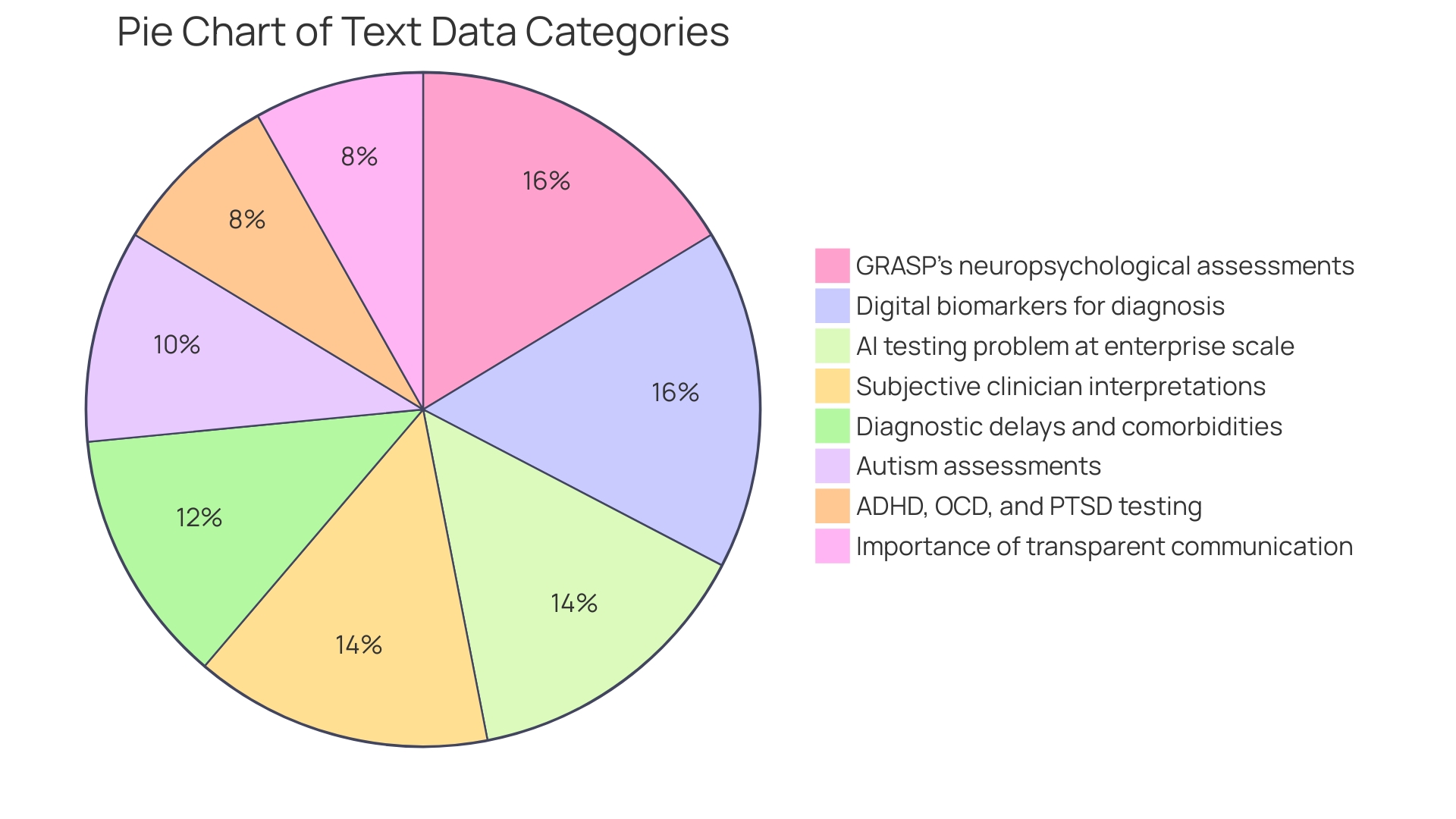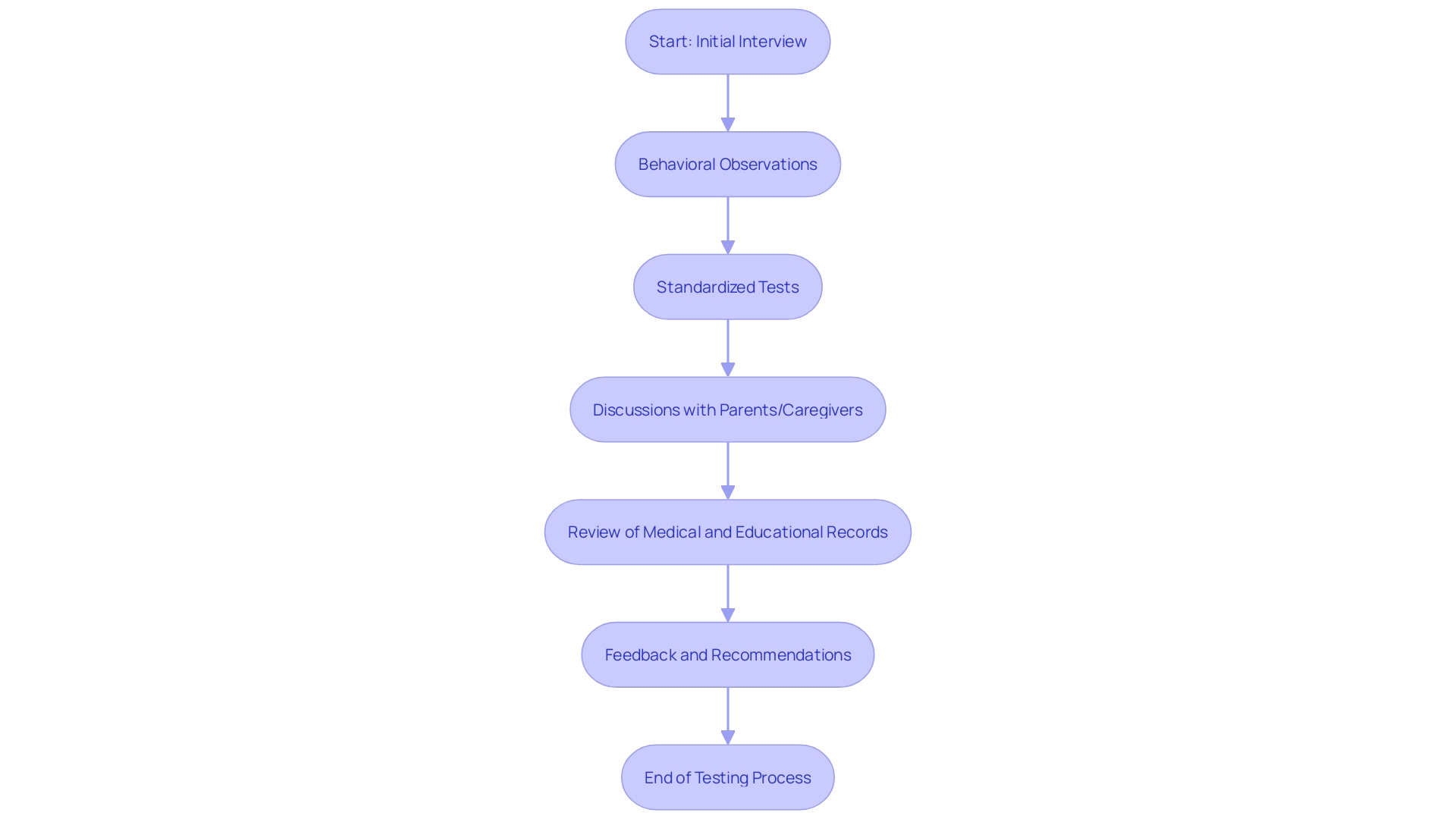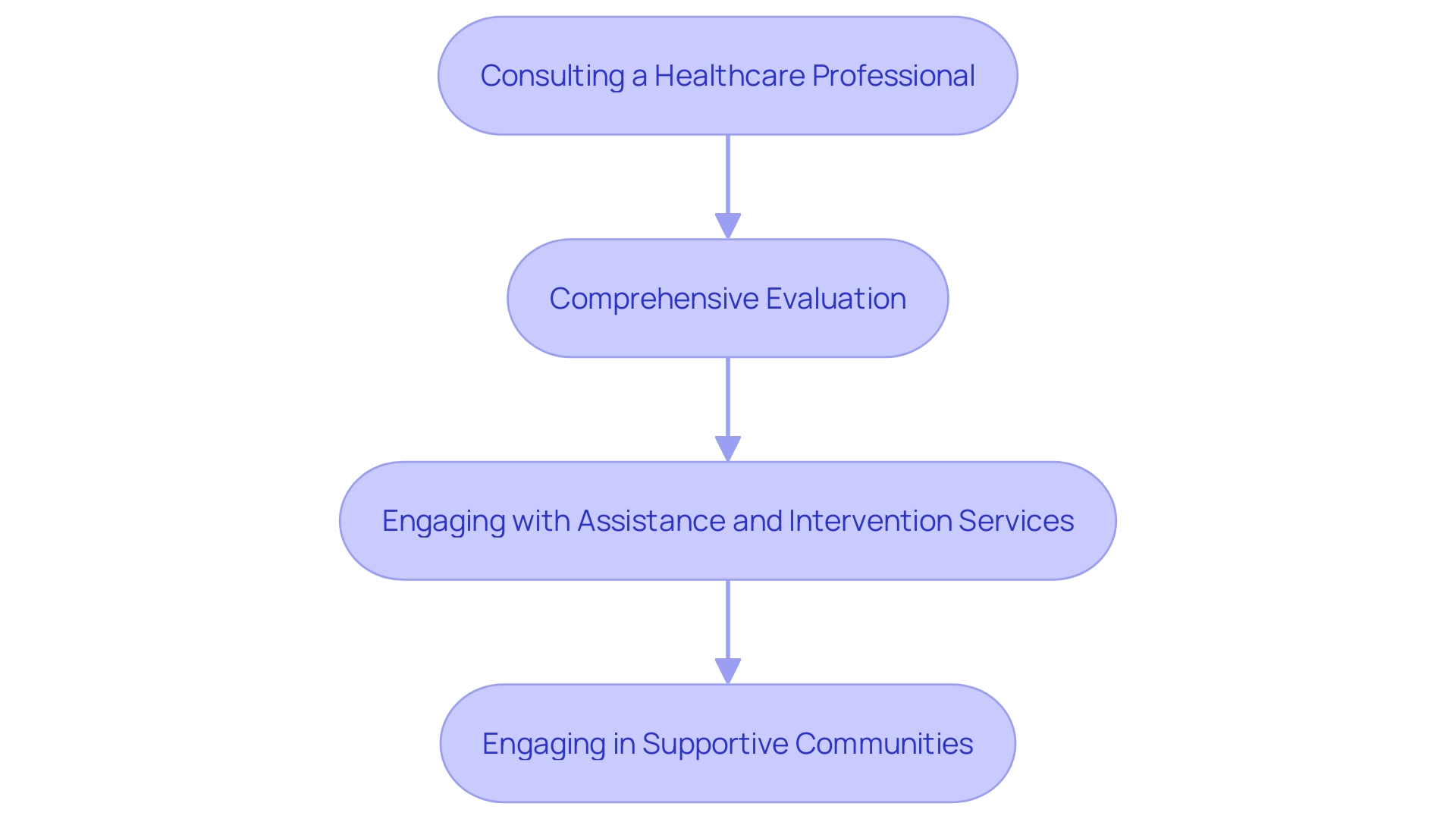Introduction
The landscape of autism spectrum disorder (ASD) assessment is evolving, with the advent of online tests providing a promising avenue for preliminary screening. These digital tools help bridge gaps in traditional testing models, offering insights into behavioral patterns that may suggest the presence of ASD. By utilizing online assessments, parents can collect initial data, making it easier to decide if seeking a professional evaluation is the right next step.
Recent initiatives, like the Oxford Health NHS Trust's development of an online diagnostic tool, underscore the importance of such accessible technologies. This article explores the types of online autism tests available, their limitations, the importance of professional diagnosis, what to expect in a professional autism assessment, and the next steps to take after an online autism test. It provides guidance and resources to help parents advocate for the well-being of their children on the autism spectrum.
Why Use Online Autism Tests?
The landscape of ASD assessment is evolving, with the advent of online tests providing a promising avenue for preliminary screening. These digital tools help to bridge gaps in traditional testing models, offering insights into behavioral patterns that may suggest the presence of ASD. By utilizing online assessments, parents can collect initial data, making it easier to decide if seeking a professional evaluation is the right next step.
Recent initiatives, like the Oxford Health NHS Trust's development of an online diagnostic tool, underscore the importance of such accessible technologies. This specific tool is being refined with the assistance of teenagers, with the goal of capturing the nuanced inner world and experiences of young people. It is a part of a broader movement towards integrating digital health products into diagnostic processes, which can provide clinicians with rich, ecological information from the comfort of one's home.
Furthermore, the openness of the community affected by the condition to self-identify challenges the idea that a formal medical assessment is always required. With many adults receiving inconclusive results, the focus shifts to the support and resources that aid individuals in thriving, regardless of a formal diagnosis.
In addition, the utilization of online tools aligns with broader trends in health information technology (HIT). Data from the National Health Interview Survey reveals that over half of adults turn to the internet for health information, highlighting the role of technology in modern healthcare management. The rise of digital biomarkers and apps like Sense to know, which use AI to predict the likelihood of developmental disorder based on children's responses to stimuli, further exemplifies this shift. These innovations offer the potential for more timely and accurate assessments, addressing the long waiting periods that can exacerbate the severity of comorbid conditions.
Online autism tests are becoming an integral part of the assessment process, offering a complementary approach to traditional methods. They empower parents with actionable information, paving the way for informed decisions about their child's developmental path.

Types of Online Autism Tests
The Autism Quotient (AQ) and its abbreviated form, the Short Autism Quotient (SAQ), serve as initial screens for ASD, offering a numerical score that reflects the presence and intensity of autistic traits. While these tools are valuable for their ease of access and ability to highlight certain behaviors, they cannot substitute for a professional evaluation, as ASD is a complex condition best assessed through a combination of caregiver insights and professional observations.
The RAADS, a thorough assessment, delves into the nuances of social interaction, communication, and sensory behaviors. It provides a detailed report that, while informative, is part of a larger, multi-faceted diagnostic process. The significance of thorough assessment is highlighted by the DSM-5's standardized criteria, which emphasize that no single tool is conclusive for determining a condition.
Focusing on Asperger's syndrome, the Aspie Quiz offers insights into cognitive and social-emotional aspects, aiding in identifying strengths and challenges. This nuanced understanding is crucial, given the diversity of the spectrum and the individualized nature of ASD symptoms.
The Repetitive Behaviors Questionnaire (RBQ) evaluates the frequency and intensity of repetitive behaviors, a characteristic feature of ASD. Understanding these patterns is vital for tailoring interventions, as early therapeutic engagement has been shown to significantly improve outcomes.
Lastly, the VIA Inventory for Autism assesses autistic traits in adults across several domains. While self-reporting measures are informative, the neurodivergent community acknowledges that a formal evaluation is not always necessary for personal validation or access to support.
In the digital realm, innovative solutions like the Sense to know app offer promising advancements. By recording and analyzing behavioral responses to stimuli, this technology can aid in early detection, which is crucial for effective intervention. As research points out, early treatment can dramatically alter the trajectory of development in children with ASD, highlighting the need for timely and accurate diagnostic tools.
Overall, while online assessments provide valuable insights, they are part of a larger diagnostic context that requires a multi-dimensional approach, including professional evaluation and the latest advancements in digital health technology.
Understanding the Limitations of Online Autism Tests
Navigating the complexities of autism spectrum disorders (ASD) can be challenging, and while online tests have the potential to offer preliminary insights, they are not definitive. These tools may miss the nuanced symptoms of ASD, leading to false positives or negatives. A thorough assessment by an expert is necessary for a dependable assessment. The neurodivergent community recognizes the validity of self-diagnosis, especially given the medical model's imperfections. However, some may seek a formal assessment to confirm their self-identification or to help others comprehend their condition. Innovative research, like the OVAAT study by CAMHS NDC pathway, aims to refine diagnostic tools, including a new online assessment, to improve accuracy and cover aspects of autism not previously addressed. Meanwhile, organizations like TACA stress the importance of timely and accurate diagnosis, advocating early intervention for better outcomes. Statistics highlight the underrepresentation of autistic individuals in the workforce and the need for supportive employment practices. Technology, particularly in the form of digital biomarkers, is emerging as a promising aid in the diagnostic process, offering the potential to capture behavioral characteristics with greater precision and facilitate early intervention. Eye-tracking technology exemplifies the advancements in this field, enabling earlier and more accurate identification of ASD signs. As the comprehension of this disorder develops, likewise should the instruments and methods we employ to identify and assist individuals on the spectrum.
The Importance of Professional Diagnosis
Professionals in the field of mental health, like psychologists, psychiatrists, and developmental pediatricians, play a vital role in evaluating and identifying autism spectrum disorder. Through a comprehensive analysis that includes behavioral observations, detailed medical history, and developmental milestones, they can offer an accurate diagnosis. This professional evaluation is more than just a label; it provides a deep insight into the person's unique strengths, challenges, and necessities. Such comprehension is crucial for creating personalized aid and interventions that can greatly improve the quality of life for those on the spectrum.
While the autistic and neurodivergent communities recognize the importance of self-identification, particularly considering the difficulties and lack of certainty that can come with professional evaluation, some people may seek a formal evaluation for validation from themselves or others. The significance of early and precise diagnosis cannot be emphasized enough, as it opens doors to vital resources and assistance that enable people to flourish. The CDC estimates that autism occurs in as many as 1 in 36 people, making the need for effective diagnostic tools and early intervention strategies more pressing than ever. Innovations in the field, like those from NeuroQure, aim to fill the gap in current diagnostic methods, offering hope for early identification and treatment, which could drastically alter life trajectories for those affected by a neurological condition.
What to Expect in a Professional Autism Assessment
Comprehending the procedure of autism testing is crucial, considering that approximately 1 in 70 people is autistic, as indicated by Autistica, with around 680,000 of working age in the UK reporting autism. This multi-step process typically includes an initial interview to gather developmental history and concerns, behavioral observations assessing social and communication skills, and standardized tests like the ADOS to evaluate specific functioning areas. Separate discussions with parents or caregivers are held for additional insights, alongside a review of medical and educational records. Finally, professionals provide feedback and recommendations, essential for interventions and support. It's important to mention that the autistic and neurodivergent community is open to self-diagnosis, especially when medical testing can yield inconclusive results, and an official diagnosis is not crucial for every person. Furthermore, recent efforts and reviews aim to enhance the employment rate and address the significant pay gap that individuals on the autism spectrum face, which is the largest among disability groups. The IACC's collaborative work with the community and stakeholders underscores the importance of coordinated efforts to enhance research and services for individuals on the spectrum.

Next Steps After an Online Autism Test
Upon receiving indications from an online assessment that a child may exhibit characteristics associated with the autism spectrum, it's critical to pursue further professional evaluation. Here's a structured approach to navigate what comes next:
-
Consulting a Healthcare Professional: It's essential to discuss the online test results with a healthcare provider, such as a pediatrician or psychologist. They can offer guidance on the necessity of a comprehensive evaluation and endorse the appropriate specialists for a thorough assessment.
-
Comprehensive Evaluation: A detailed evaluation by a specialist in autism spectrum disorders is the next pivotal step. This in-depth assessment will delve into the individual's unique strengths and challenges, providing a clearer picture of their specific needs. This is crucial for developing customized assistance approaches.
-
Engaging with the appropriate assistance and intervention services is crucial after a confirmed diagnosis. Options may include specialized therapies, educational programs, and access to community resources. These services are instrumental in promoting the growth and potential of individuals with autism spectrum disorder.
-
Engaging in Supportive Communities: Emotional assistance, shared encounters, and practical guidance can be found in different supportive communities, such as parent support groups or online forums devoted to individuals with developmental challenges. They serve as valuable resources for families navigating the complexities of the spectrum disorder.
It is crucial to acknowledge that while online tests can indicate the possibility of a developmental disorder, they are simply an initial measure. Ongoing assistance, accompanied by continuous aid, plays a vital part in the person's growth and welfare. Furthermore, it is important to highlight that despite the potential shortcomings in the medical testing framework for individuals with autism, which may result in inconclusive outcomes, the importance of a diagnosis can be substantial for certain people, especially in validating their encounters and obtaining specific kinds of assistance.
Furthermore, current research underscores the importance of evidence-based interventions in autism care. Clinicians rely on the latest studies to determine the most effective treatments, with educational approaches like the TEACCH program emphasizing the benefits of consistency and visual learning for those on the spectrum.
Lastly, as we work towards a more inclusive society, it's crucial to acknowledge the barriers faced by people with autism in the workplace and make efforts to enhance employment rates and conditions for this community. This includes raising awareness, reducing stigma, and preparing individuals for meaningful careers that leverage their unique talents and abilities.

Conclusion
In conclusion, online autism tests offer valuable preliminary screening for autism spectrum disorder (ASD) and empower parents to make informed decisions about seeking professional evaluation. However, it's important to recognize their limitations as they may miss nuanced symptoms of ASD.
Professional diagnosis by specialists is crucial for an accurate assessment of ASD, providing deep insights into an individual's unique strengths and challenges. This understanding allows for tailored support and interventions that enhance quality of life.
While self-diagnosis is valued within the autistic community, seeking a formal diagnosis can provide personal validation and access to support. Early and accurate diagnosis is essential, as it opens doors to vital resources and interventions that enable individuals to thrive.
The process of autism testing involves interviews, behavioral observations, and standardized tests, with professionals offering valuable feedback and recommendations for interventions and support.
After an online autism test indicates a possibility of ASD, further professional evaluation is critical. Consulting a healthcare professional and undergoing a comprehensive assessment are essential steps. Accessing support services and joining supportive communities can provide valuable resources and emotional support.
While online tests are helpful, they are not definitive. A formal diagnosis, followed by ongoing support, is crucial for an individual's development and well-being. Efforts to improve employment rates and conditions for autistic individuals are important for fostering an inclusive society.
By understanding online autism tests, the importance of professional diagnosis, and the next steps after an online test, parents can advocate for their children's well-being on the autism spectrum. Through their empowered actions, individuals with ASD can thrive and reach their full potential.
Take the next step and seek a formal diagnosis for personal validation and access to support.




